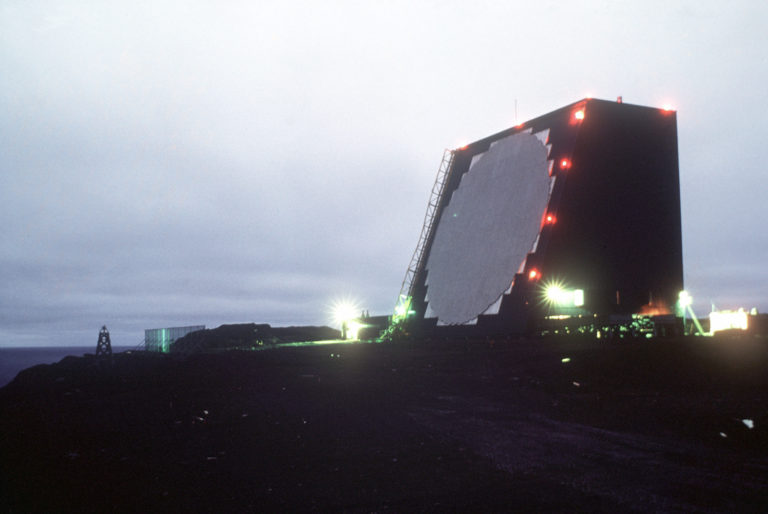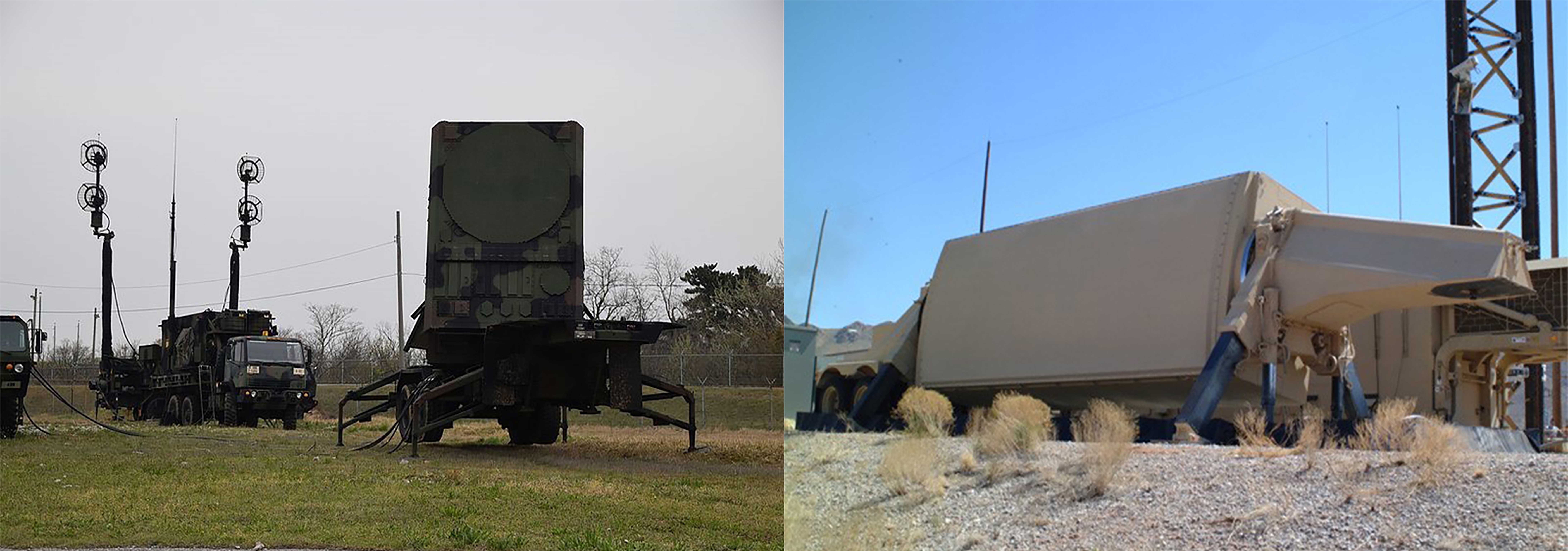Bad Idea: Sectored Air and Missile Defense Radars

In a world where unmanned aerial vehicles are plentiful, cruise missiles are becoming more abundant, and hypersonic boost glide vehicles are just over the horizon, air and missile threats are coming from all directions. To address the realities of this environment, effective defenses require an air and missile defense sensor architecture that looks in all directions as well.
To a great extent, however, the Pentagon is persisting in old habits of buying narrowly sectored radars—those that look in only one direction. Sectored ground-based radars are not only a mainstay of regional defenses like Patriot and the Terminal High Altitude Area Defense (THAAD), but also comprise the majority of the sensors supporting the Ground-based Midcourse Defense (GMD) program for long-range missile defense (see Table 1). This approach was good enough for the simple ballistic missile threats of the past, but not for the complex, multi-domain threats of the future.
Given the National Defense Strategy’s focus on major powers like Russia and China, the U.S. air and missile defense enterprise must be reoriented to deal with the specter of integrated air and missile attack, and that reorientation must include a different approach to sensors.
Omnidirectional Threats
After the Cold War, Americans came to take air superiority as a kind of birthright. The Pentagon’s corresponding neglect of air defense has caught up with it. The joint force now faces a more complex and contested aerial-threat environment than ever before.
Past air and missile defenses focused on threats with more-or-less predictable trajectories. Today’s threat spectrum is far more diverse. Even a poor man’s air force today may have drones and cruise missiles that can fly around sectored sensors to kill them in their blind spots. Maneuvering ballistic missiles, radiation-seeking missiles, and hypersonic glide vehicles in the upper atmosphere make it even harder to detect, track, and engage threats.
Of particular concern is the prospect that U.S. air defenses could be suppressed by complex, integrated attacks. In June 2017, North Korea used a UAV to surveil the Terminal High Altitude Area Defense (THAAD) ballistic missile defense battery in South Korea. Had it instead attacked the TPY-2 radar, it could have incapacitated THAAD on the Korean Peninsula. Yemen’s Houthis, meanwhile, openly brag about using drones to target Saudi Patriot radars. In Syria and Ukraine, Russia has demonstrated the lethal effect of integrating electronic attack, drones, artillery, and short-range ballistic missiles.

The Army’s Sectored Coverage
Secretary of the Army Mark Esper has championed a much-needed and robust modernization effort tailored around “Multi-Domain Battle,” which presupposes a sophisticated set of threats from near peers, including the potential lack of air superiority.
To address these concerns, the Army has created a cross-functional team for air and missile defense, reconstituted maneuver short-range air defense units, and established the Army Futures Command. Chief of Staff of the Army and incoming Chairman of the Joint Chiefs, General Mark Milley, has spoken forcefully about the importance of air defense for the joint force. Relative to other aspects of Army modernization efforts, Milley said, “None of this is going to matter if you’re dead. And that’s why you need air defense.”
One of the important steps for the Army is the advance of the long-awaited new Patriot radar, called the Low Tier Air and Missile Defense Sensor (LTAMDS). But press reports and statements from Army leadership confirm that the 360-degree requirement for the radar has been quietly walked back.
When asked recently why the Army no longer had a threshold requirement for 360-degree coverage for LTAMDS, Secretary Esper indicated it was to focus on near-term goals prior to 2028, making reference to the Army’s other (badly needed) efforts like Maneuver-Short Range Air Defense (M-SHORAD).
In last year’s defense bill, Congress warned the Army that if it did not have a plan to produce a 360-degree LTAMDS by 2023, then the program and its budget would be transferred to the Missile Defense Agency. The Army dutifully turned in a report on how it planned to do so, but then more recently proceeded to downgrade the omnidirectional capability to a possible future objective aspiration rather than the threshold requirement it deserves to be.
Esper’s reference to delaying 360-degree capability for LTAMDS in order to meet a 2028 timeframe seems odd given that the Army was already on track to deliver an omnidirectional LTAMDS radar before then, possibly by 2023. It is almost as if the Army is daring Congress to make good on its previous threat.
One stated justification for deprioritizing LTAMDS’ 360-degree capability is that gaps might be filled by stitching together sectored radars or by tethering to other unspecified assets. To be sure, network centrism represents the future of integrated air and missile defense. The Army has prudently advanced the “any sensor, best shooter” vision, integrated fire control via the Integrated Air and Missile Defense Battle Command System (IBCS), and other near-term interoperability improvements.
But integration is no substitute for a fire unit fighting effectively on its own. Data from supporting sensors may not always be available due to competing missions, battery dispersal, network degradation, cyber attack, or maneuver. Retaining 360-degree coverage at the element or battery level supports both resilience and flexibility by allowing commanders to send self-sufficient, untethered batteries wherever needed.
These operational considerations matter. The complexity of the threat is too great for the omnidirectional requirement to be explained away.
Hawaii’s One-sided Radar
Another example of doubling down on sectored coverage is with a new radar designed to improve the protection against intercontinental ballistic missiles. The Missile Defense Agency currently plans to build two Pacific radars to improve coverage against this threat with a cost of about $2.5 billion. This sum represents about five percent of MDA’s research and development funds and 54 percent of its military construction budget between 2019 and 2023. Under current plans, the radar being built first in Hawaii will almost certainly be limited to looking in the general direction of North Korea.
Because of plans to retire or relocate the Sea-Based X-band Radar and the northerly location of another radar in Alaska, the Pacific radars will help mitigate the so-called “midcourse gap” in the Pacific. Especially after Hawaii’s text-message false alarm in 2018, the political desire for such a capability is even more understandable.
But while the Pacific radars will improve capability at the margin, they are simply not designed to deal with other complex threats, especially those that maneuver in the atmosphere. While providing significantly greater capability against a North Korean ICBM attack, these radars are inadequate for advanced cruise missiles or maneuvering glide vehicles which can fly below or around their field of view. If allowances are not made for subsequent buildout to 360-degree coverage, the Hawaii radar will forever be limited to the single mission of ballistic missile defense against long-range ballistic missiles emanating from the vicinity of North Korea.
The implications of the National Defense Strategy for missile defense have yet to be fully debated, but that conversation must be had. If the Pentagon is serious about refocusing on more advanced threats from the near peer, the United States may need to accept some greater near-term risk with North Korea.
A New Sensor Roadmap Needed
High level strategic choices will necessarily have implications for subordinate air and missile defense elements. A more fulsome sensor roadmap could, for instance, include more elevated assets in the air and in space; smaller, cheaper, more numerous, and more distributed assets; a more diverse set of technologies across the electromagnetic spectrum; more integration with other, non-dedicated sensor sources across the joint force, whether artillery radars or F-35s; and, finally, more advanced radar capabilities and operations.
A space sensor layer with persistent, global coverage for birth-to-death tracking and discrimination is at the top of the list of sensor priorities. Although long overdue, even that sensor layer will not be all capable. Although in missile defense circles “layering” is more commonly associated with interceptors, it should really be applied to sensors, utilizing different technologies across all domains and in a variety of orbits.
Surface-based air defense radars will be with us for the foreseeable future, and there are numerous ways in which future radars can be improved, including by making them more capable, disaggregated, diverse, and survivable. But we should not make it any easier for an adversary to suppress U.S. air defenses. The Navy’s Aegis Weapon System and its associated omnidirectional radars provide a kind of example to the joint force generally and more particularly for the Ballistic Missile Defense System (BMDS). Just as carrier groups must be defended against a wide range of aerial threats from any direction, so too must the larger joint force.
It is time to decisively move away from stand-alone sectored coverage from air and missile defense radars. The new default expectation should be that all dedicated air and missile defense radars should either themselves have or be part of true 360-degree coverage. The threat permits nothing less.
Table 1. The Overly-Sectored BMDS Sensor Architecture
| Sensor | Platform | Domain | Missions | Technology | Date Fielded | Field of view |
| SBX | Modified oil rig | Sea | Midcourse discrimination | RF (X-band) | 2005 | 360 |
| SPY-1 | Aegis ships, Aegis Ashore | Sea and land | Tracking, surveillance, fire control | RF (S-band) | 1983 | 360 |
| LRDR | Radar Complex, Clear, AK | Land | Discrimination | RF (S-band) | 2020 | 240 |
| UEWRs | Radar Complexes, Fylingdales, UK, Beale, CA, Thule, Greenland | Land | Early warning and tracking | RF (UHF) | 1960-1977/upgraded 2005-2009 | 240-360 |
| Cobra Dane | Radar Complex, Shemya, AK | Land | Tracking and classification | RF (L-Band) | 1977, BMDS upgraded in 2004 | 136 |
| TPY-2 | Towed, transportable | Land | Forward-based (for GMD) and terminal (THAAD) | RF (X-band) | 2008 | 180 |
| OPIR/SBIRS | Geosynchronous Earth Orbit and Highly Elliptical Orbit | Orbit | Early warning | IR | HEO- 2006
GEO- 2011 |
Overhead |
| STSS-D | Low-earth Orbit | Orbit | Tracking and discrimination
(demonstration and test assets) |
EO/IR | 2009 | Overhead |
| Patriot radars | Towed, transportable | Land | Search, identification, tracking, and fire control | RF (C-Band) | Patriot: 1985
PAC-2: 1994 PAC-3: 2003 |
120 |
(Photo of Cobra Dane Radar at Eareckson Air Station, Shemya Island, Alaska, courtesy of Missile Defense Agency)

